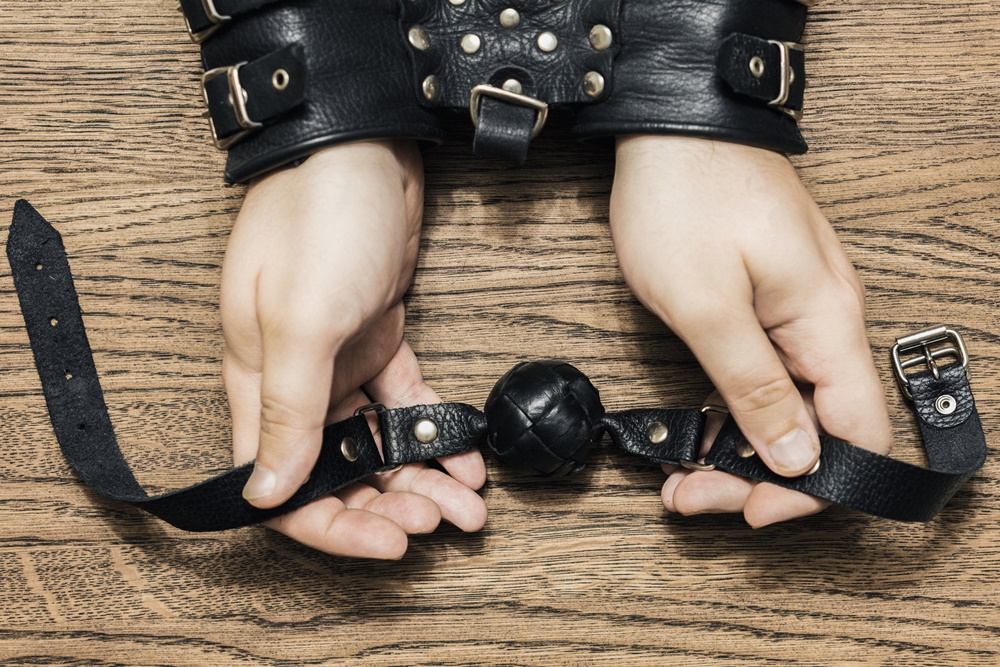Leather and kink go hand in hand. If you conjure up the idea of BDSM, it almost always includes leather in some way—restraints, paddles, pants. It’s such a ubiquitous part of kink and fetish fashion that just imagining a fetish party makes us think of leather clothes like skin-tight pants, bustiers, or boots.
Let’s take a look at the history of leather kink and how leather evolved from second skin to erotic symbol.
Leather Culture and the Gay Community
While leather is a central part of the material for fetish clothing and bondage restraints, the idea of leather culture brings to mind the gay movement.
The leather community conjures visual ideas of gay men, often bears—large, hirsute guys—in leather harnesses, chaps and caps à la Freddie Mercury. The leather kink is very common in gay culture and part of the history of gay fetish as well as a visual aspect of the equal rights campaign.
Leather culture as part of gay culture was part BDSM and part visual identifier, so that gay men would easily recognize each other and be able to communicate what they were into. There were strict rules and regulations in The Leatherman’s Handbook as to who did what, where, and how.
But that underground culture came from older underground cultures. Leather was nothing new to biker communities, for example, and even if it wasn’t “just” sexual, the freewheeling, outlaw lifestyle was definitely about shirking bourgeois sexual mores and flouting religious and social dictums about sex.
Read: 6 Bad Boy Types & Why Women Love Them
Early Origins of Leather Kink
Bikers, gay men, and other leather undergrounds were only tapping into something much older and more widespread.
Animal skins have long been practical and utilitarian materials to use for bags, blankets, belts, and tools; and they have long been associated in some ways with the erotic. Handling animal skin, using it on our feet or for warmth as a blanket, and showing it off as a symbol of status or quality have all meant that human pleasure has often been associated with leathers.
A rare or exotic animal skin could denote status and wealth in a house, palace, or harem. We have long associated the idea of fur carpets or coats with sexy women, frolicking on a bear rug or wearing a fur to a cocktail party.
Leather’s appeal may run deep in our veins, when survival depended on hunting. Animal skins would broadcast a man’s ability to provide for a woman and his family, and thus be a sign of his superiority over fierce beasts as well as over other men.
The appeal of leather is not always aggression, however, we have always worked with animals and found it fulfilling, earthy, sensual, and elemental. Horses, camels, sheep—living creatures, with various smells and sounds, helping us on farms, in deserts, and in travel. We made use of the creatures instead of wasting their bodies when they died, making clothes and tools from their skin and bones. The scent of animal skin is elemental to many and familiar through a very long association from prehistory.
Leather is literally animal skin, and the second-skin theory posits that our fetish appeal is because it feels naked in a way. The scent, feeling, and appearance of leather are erotic to many. It may have an animal feel, or a natural and elemental look.
The Power of Leather Clothing
Leather kink may be more about the toughness and power it suggests—leather has long been associated with rock ‘n’ roll, or fearless, horny dominants.
It can be both masculine and feminine, depending on cut, evoking virility and raw male energy on the one hand, and with a kid-soft treatment and feminine tailoring, it can accentuate the powerful feminine archetype as well.
We frequently eroticize clothing of all kinds, which makes perfect sense as clothes cover the body and become part of the identifier of an individual as well as a culture and era. Underneath those clothes is the naked body, and so it is natural that we are attached to certain garments.
“The Victorians went crazy over silk and velvet,” writes Pat Califia in Public Sex: the Culture of Radical Sex. “As quickly as new substances were manufactured, somebody eroticized them.”
Leather Fetish and BDSM
Since leather has been part of the history of both practical clothing and fashion in many if not most cultures, for thousands of years, it makes sense that it is such a commonly eroticized fabric.
The aesthetic is powerful, and sensual, appealing to touch, smell, and look. For many leather kink lovers, it is actually the feel of leather on their skin.
In traditional psychology definitions of “fetish”—when we consider an object or fixation standing in for the act of sex or for the target genitalia—touching or wearing leather itself can be more important than who you’re with, or who is wearing it. Some of you are content just to fondle leather garments or wear them yourself for gratification, from underwear to gloves to a jacket.
Read: Leather Fetish Explained
Most leather love (but not always) takes place alongside, or as an integral part, of some kind of BDSM play.
Whips, restraints, paddles, cuffs, harnesses, blindfolds, and more are often made of leather. Some bondage and discipline disciples don’t want any other materials in their sadomasochism rituals. They want their mistress to wear leather boots and shoes, leather pants or skirts, leather corsets, and to use leather implements of torture.
To say there is a kinky leather culture is true, to say there are leather subcultures is more accurate. But in fact leather as erotica is nothing new and has been a part of us from the dawn of humankind.
Do you have a leather kink? Please share in the comments.




Tell us what you think